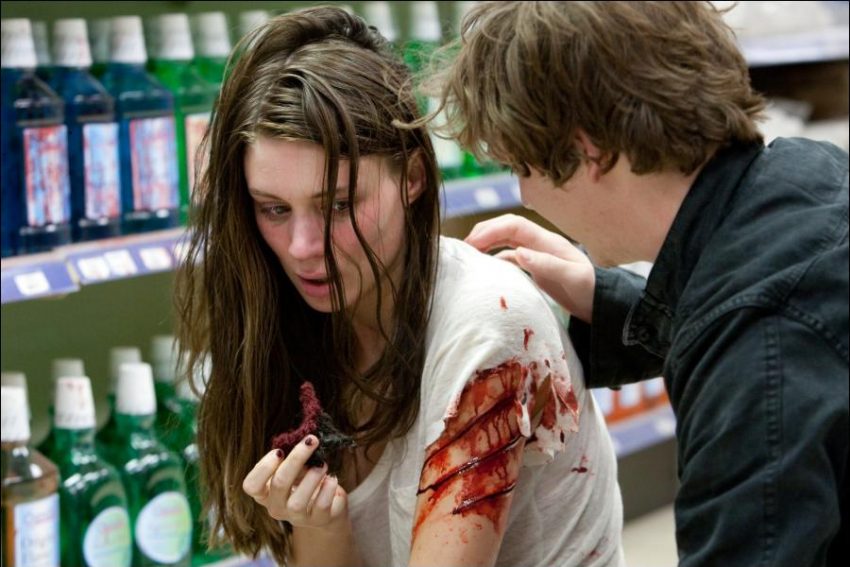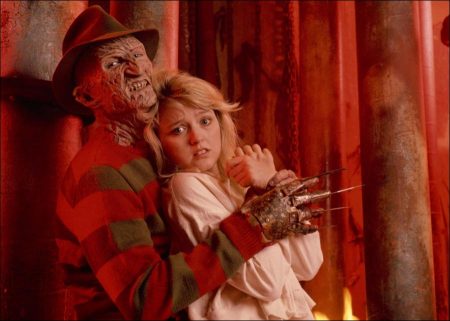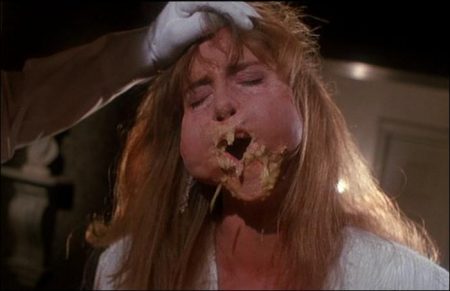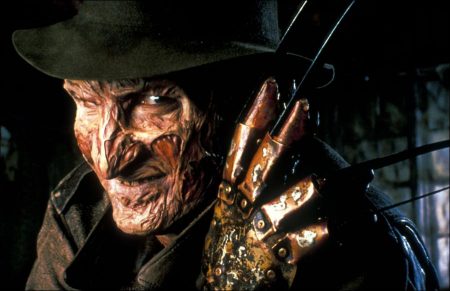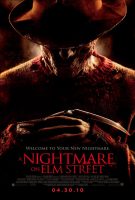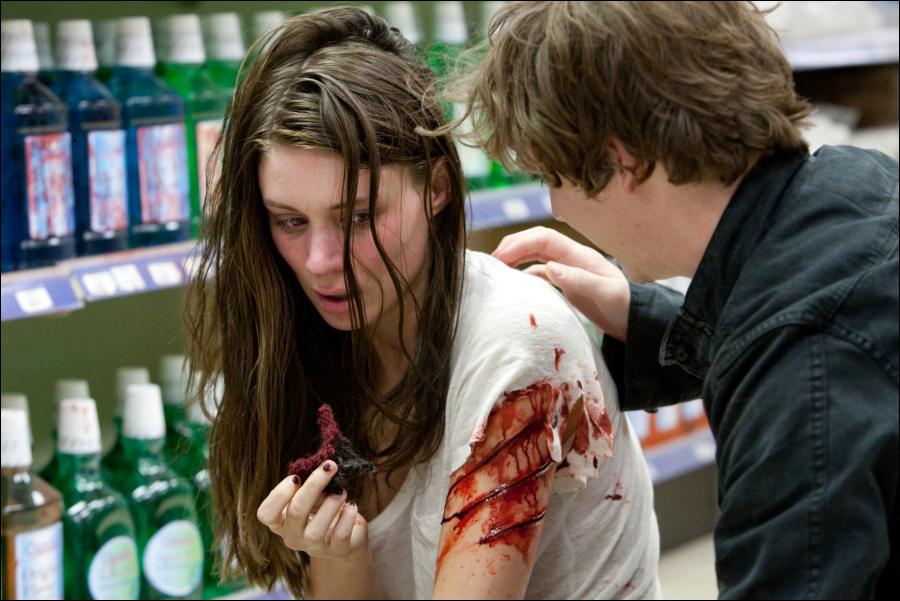Taglines: He knows where you sleep.
Nancy, Kris, Quentin, Jesse and Dean all live on Elm Street. At night, they’re all having the same dream-of the same man, wearing a tattered red and green striped sweater, a beaten fedora half-concealing a disfigured face and a gardener’s glove with knives for fingers. And they’re all hearing the same frightening voice…
One by one, he terrorizes them within the curved walls of their dreams, where the rules are his, and the only way out is to wake up. But when one of their number dies a violent death, they soon realize that what happens in their dreams happens for real, and the only way to stay alive is to stay awake. Turning to each other, the four surviving friends try to uncover how they became part of this dark fairytale, hunted by this dark man. Functioning on little to no sleep, they struggle to understand why them, why now, and what their parents aren’t telling them.
Buried in their past is a debt that has just come due, and to save themselves, they will have to plunge themselves into the mind of the most twisted nightmare of all… Freddy Krueger.
A Nightmare on Elm Street is a 2010 American slasher film directed by Samuel Bayer, and written by Wesley Strick and Eric Heisserer. The film stars Jackie Earle Haley, Kyle Gallner, Rooney Mara, Katie Cassidy, Thomas Dekker, and Kellan Lutz. It is a remake of Wes Craven’s 1984 film of the same name; produced by Michael Bay and Platinum Dunes, it is designed to reboot the Nightmare on Elm Street franchise. The film centers around a group of teenagers being stalked and murdered in their dreams by a man named Freddy Krueger, ultimately discovering they all share a common link from their childhood that is making them targets for Freddy.
As of July 6, 2010, A Nightmare on Elm Street has earned $63,071,122 at the domestic box office. With its $63 million in domestic box office, A Nightmare On Elm Street is the second-highest-grossing film among the recent slasher remakes, like When a Stranger Calls (2006), Black Christmas (2006), Halloween (2007), Prom Night (2008), and My Bloody Valentine 3D (2009) but behind Friday the 13th with $65 million. The film was officially released overseas on May 8, 2010. In its opening weekend, it took in approximately $6.5 million throughout ten foreign territories. It also secured first place for the weekend at the Russian box office, with $3 million. Since its opening, the film has taken in approximately $52,332,285 in the overseas box office, giving it a worldwide total gross of $115,407,296.
Welcome to Your New Nightmare
One, two, Freddy’s coming for you…
“A Nightmare on Elm Street is a reinvention of the seminal 1984 horror classic that unleashed Freddy Krueger upon the nightmares of a generation of fans. Now, a new Freddy Krueger, embodied by Oscar nominee Jackie Earle Haley, is born. Welcome to your new nightmare.
“Freddy Krueger is the mythical boogeyman, says Haley, who breathes new life into Freddy Krueger in “A Nightmare on Elm Street. “He’s everyone’s worst nightmare… the character in the campfire story.
“Real horror, when you think about it, relates to things on a very human level, notes Samuel Bayer, the acclaimed commercial and music video director who makes his feature film debut with “A Nightmare on Elm Street. “And we all dream; it’s universal.
“To me, the most terrifying aspect of Freddy Krueger is that he comes to kill you in your sleep, when you’re at your most defenseless, says producer Michael Bay. “In your dreams, there’s nowhere to hide. You can’t escape, and he won’t stop until you either die or wake up. He provokes fears we all have.
Producer Brad Fuller attests, “In watching horror movies, you often wonder how people can put themselves in such dangerous situation, but the thing with ‘A Nightmare on Elm Street’ is that no one can stay awake forever.
“Freddy’s got nothing but time, adds producer Andrew Form. “All he has to do is wait, and eventually you’ll end up in his world.
Wes Craven wrote the original “A Nightmare on Elm Street after he became inspired by a series of newspaper articles about children who had suffered through a war and died from the power of their recurring nightmares. Released in 1984, the initial low-budget film, which starred Robert Englund as Freddy, became an international sensation for New Line Cinema-affectionately called “The House That Freddy Built-and spawned a number of sequels.
Now, more than two decades later, Bay, Form and Fuller, whose Platinum Dunes production company has created a niche for reimagining classic horror properties, felt the time was right to unleash Freddy on a new generation of fans. “Growing up, I always felt that if I died in my dreams I would actually die, and that didn’t come from hearing it on the news; that came from seeing the ‘A Nightmare on Elm Street’ movies, Form says. “They scared the hell out of me as a child.
Director Samuel Bayer has proven his ability to blur the lines between the real and the unreal and in him the producers saw the ideal sensibility for creating the ultimate nightmare. Form asserts, “Sam has created some of the most enduring images in his video and commercial work, and we were excited to pair him with this story.
Screenwriters Wesley Strick and Eric Heisserer used Craven’s 1984 film as a blueprint but evolved the ideas further as they explored the psychologically resonant elements of the character of Freddy Krueger. “Trying to write Freddy in a fresh way led me back to the Pied Piper, who’d punished a town by taking away its children, says Strick. “When I learned the term ‘pied’ meant ‘stripes of contrasting colors,’ just like Freddy’s famous sweater, it felt like a sign that I was on the right track-making Krueger even scarier by painting him as a righteous avenger, a dimensional villain who’s complex and more human and who may have been falsely accused.
Freddy’s home turf-where he is in total control-is the world of sleep and dreams. Bayer offers, “Through the centuries, people have tried to figure out their own psyches and why they dream, and why some people fear sleep. At some time in life, we’ve all tried to stay awake for something. We know what it feels like when you get tired and your eyes just can’t stay open. Usually it just means you fall asleep, but in this movie, you could actually die.
Heisserer found that research into this phenomenon uncovered an inescapable fact about sleep: after enough days without it, the brain shuts down to automatically recharge. Even as the teens of Elm Street resort to questionable methods in order to stay awake-from chugging energy drinks to downing prescription psychostimulants-without their knowledge they slip into a micro-sleep state.
“Micro-sleep causes you to fall asleep even for a few moments at a time, Heisserer explains. “Even though you’re still conscious and awake, part of your brain is asleep. So, that phenomenon allows Freddy to get at the characters in the story even when they’re awake…no matter where they are.
A New Freddy Krueger Is Born
Three, four, better lock the door…
With a charred, disfigured face, an unforgettable voice, and a wicked sense of humor, Freddy Krueger is both a physical and psychological predator as he invades the dreams of suburban teenagers and kills them in their sleep. The sense of palpable danger and genuine horror rests in the embodiment of the monster at the film’s core: Freddy Krueger, played by Jackie Earle Haley.
Haley recalls that fans of the original “Nightmare filled the internet with speculation about him portraying Freddy after the project was announced. “My immediate reaction was, ‘That’s kind of cool!’ And then when the producers called and actually offered me the role, I was pretty flabbergasted. It’s such an amazing, iconic character. It was just an absolute honor to be offered the role of Freddy.
“Jackie embodied everything that we wanted for this role, states Fuller. “The fans were aware of him, and he’s a brilliant actor. We knew we wanted to make a seriously scary movie, and it would be impossible to tell this story without an actor of Jackie’s caliber. We’re not trying to replicate what was done in the past. Jackie made Freddy Krueger his own.
Haley plunged into the mythical aspects of the character to internalize what it was about him that resonated so universally. “Getting to play Freddy was exciting and challenging because, as this mythical boogeyman that we all love to be frightened by, there’s a lot that makes him tick, the actor says. “It’s fascinating that what’s scary on screen has triggers in outside life, and Freddy encompasses so much of what terrifies us.
Haley also credits his predecessor, Robert Englund, for giving the role such power and wicked humor. “It was a very cool process for me, trying to figure out how to make Freddy my own, Haley reveals. “Robert did an amazing job portraying Freddy over the years. He made him who he is. What we’re doing with Freddy with this new approach is still trying to be true to those things that fill him with rage, and the specifics that make him the malevolent villain that he is. But I think we’re trying to capture him in a new that’s darker, and a little bit more serious, less jokey and, hopefully, more scary.
Bayer has nothing but praise for Haley’s work. “This is definitely Jackie’s take. He created a character that you’re going to hate and be scared of, but, at the same time, you’re going to have empathy for him-it’s all what Jackie brought to it.
At the suggestion of the filmmakers, Haley researched serial killers in preparation for the role, but ultimately chose to take Freddy out of the realm of fact and into the realm of myth. “I realized I wasn’t playing a serial killer, he affirms. “I wanted to be true to who Freddy Krueger is and yet still bring a little bit of realism to his back story and what it was that turned him into this.
A New Elm Street
Nine, ten, never sleep again…
Working with production designer Patrick Lumb, Bayer sought to use the locations to create a familiar suburban world so safe that Freddy’s intrusion is all the more jarring. By contrast, Freddy’s world was in part inspired by the dark, fantastical paintings of late 18th/early 19th-century Spanish artist Francisco Goya. “What we tried to do was to base the dream world on the real world, and craft rich and exciting transitions between them, Lumb states. “Working on dreamscapes and inventing a world around Freddy was one of the great joys of this project for me.
The filmmakers found their classic Midwestern town in Chicago, Illinois, and surrounding suburbs, as well as neighboring Gary, Indiana. With all the principal characters being students at Springwood High School, the production utilized two local high schools: John Hersey High School in Arlington Heights, a northwest suburb of Chicago, for interiors; and Elk Grove High School in nearby Elk Grove Village, for exteriors and establishing shots.
The filmmakers shot during school hours, and enlisted hundreds of students and teachers to become background extras for the various sequences shot at the high schools. In addition to exteriors, Elk Grove also offered a cavernous indoor swimming pool, where Quentin is a swim team member of the Springwood Mustangs, with his fellow swim team members being played by Elk Grove’s water polo and swim teams.
The second week of filming took place entirely in the historic neighborhood of Jewel Park, a circa 1920s upper middle class suburb in the village of Barrington, Illinois. Linden Road, a winding street lined with large two-story homes, portrays the film’s iconic Elm Street, where Nancy and Kris’s homes are located across the street from each other. In homage to the original “A Nightmare on Elm Street, Nancy’s home was numbered 1428 Elm Street, the same address Nancy had in the original.
One of the most cinematic and creepy locations was the historic City Methodist Church in Gary, Indiana, an abandoned nine-story tall English gothic church, which now sits in picturesque ruins. This became the setting for one of Quentin’s encounters with Freddy Krueger.
Freddy’s most personal space is the steamy, fiery boiler room, a specter of the “A Nightmare on Elm Street mythology. These sequences were filmed over four nights at a power station in South Chicago. The multi-level industrial facility was outfitted by the film’s art and special effects departments to feature vintage boiler room equipment as well as steaming pipes, smoke, fire, dripping water, and big chains where Freddy could hang his victims.
The production also utilized the historic former ACME Steel plant (now the Beemsterboer Steel Plant) and nearby training center in Chicago, which the art department transformed into the Badham preschool, where Fred Krueger worked as a caretaker 15 years earlier. “The steel plant was very industrial and down and out, but it was perfect for us, Lumb remarks. “We did an extensive amount of work on the exterior and the interior. The classrooms were all fabricated from the doors, to the color on the walls, to the flooring, and everything else. One of the nice things about the preschool set is you feel a little bit enclosed. It’s kind of ominous in a way because it’s similar to a jail cell, but at the same time you can ‘friendly it up’ to give the illusion of safety, even though it’s anything but safe.
Other notable Chicago area locations included Bluff City Cemetery, a late 19th century gothic cemetery in Elgin; Powell’s Bookstores in Chicago’s Lincoln Park neighborhood; Michael Reece Hospital in Chicago; Hawthorne Pharmacy in Cicerop; and the ultra-modern Orland Park Police Station in Orland Park, the first LEED (Leadership in Environmental Design) Gold Certified Police Station in the U.S.
Many of the film’s interiors, along with some green-screen sets, were erected on two soundstages at Chicago Studio City, an independent studio and production services facility. Over the course of three weeks of filming on stage, some of the prominent sets included the charred and water-filled classroom sets from Kris’s nightmare; Kris’s bedroom sets; Nancy’s art-filled bedroom where Freddy stretches out from the wallpaper above her bed, and the bathroom where his bladed hand emerges from under the water.
The burnt classroom and water-filled classroom sets were among Lumb’s favorite, and most challenging, sets to design. For the water-logged classroom, Lumb referenced a book of photographs from the New Orleans flood from Hurricane Katrina to give these nightmarish images a solid basis in what could be.
Producer Bay credits Bayer for creating a film that seamlessly juxtaposes the physical world and the dream world that is Freddy’s domain. “In many ways, they’re dark mirror images of each other, he asserts. “Both are very real, very visceral, but the safety and security of this comfortable and suburban town and high school become the lie, because the dream world is where these kids have to fight for their lives. They have to believe in it completely, and the audience also has to believe in it completely. Sam did an incredible job creating this jarring dichotomy.
Bayer reflects, “It’s an urban fairytale. It’s what scares you. As the kids in the movie fight so hard to stay awake, the switch between the real world and the dream world happens even more quickly, so it’s a ride. But we wanted to create a situation in which this nightmare scenario is grounded in truth, to the point that you wonder, ‘Can someone actually kill you in your sleep?’
A Nightmare on Elm Street (2010)
Directed by: Samuel Bayer
Starring: Jackie Earle Haley, Rooney Mara, Kyle Gallner, Thomas Dekker, Kellan Lutz, Katie Cassidy, Connie Britton, Julianna Damm, Christian Stolte, Leah Uteg, Don Robert Cass, Katie Schooping Knight
Screenplay by: Wesley Strick
Production Design by: Patrick Lumb
Cinematography by: Jeff Cutter
Film Editing by: Glen Scantlebury
Costume Design by: Mari-An Ceo
Set Decoration by: Karen Frick
Art Direction by: Craig Jackson
Music by: Steve Jablonsky
MPAA Rating: R for disturbing images, language, strong bloody horror violence, terror.
Distributed by New Line Cinema
Release Date: April 30, 2010
